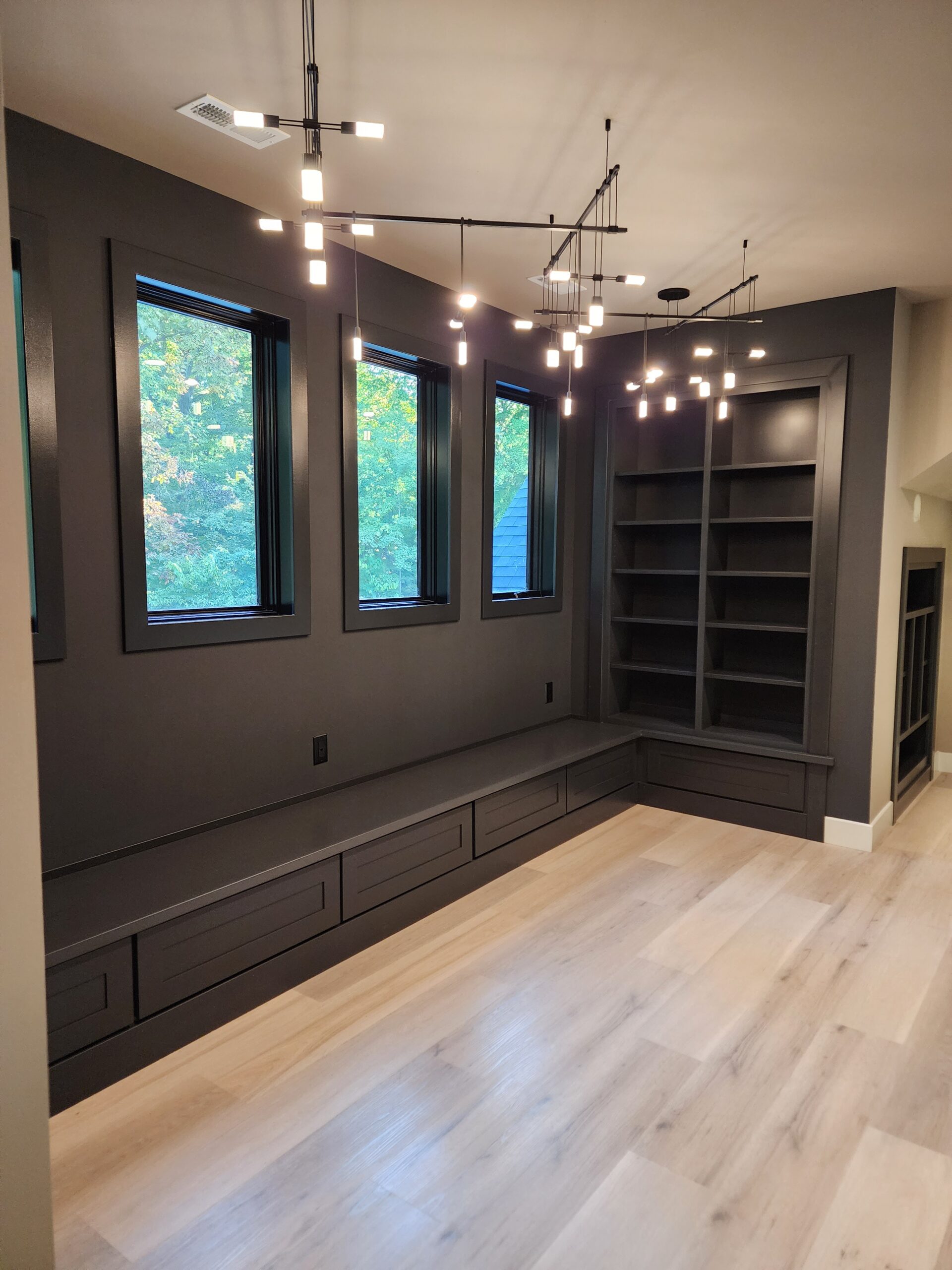Few things are more disappointing than standing back after painting and spotting uneven streaks, dull patches, or visible lap lines that weren’t there minutes ago. These roller marks—often called lap marks—are the telltale signs of uneven paint application or improper drying between strokes.
The good news? With the right paint, tools, and technique, you can stop roller marks before they ruin your walls. At LiteHouse Painting, we’ve helped countless homeowners in Bellbrook, OH get flawless finishes through our expert interior house painting services.
In short: Use premium self-leveling paint, choose the right roller cover, maintain steady pressure, work with a wet edge, and control your room’s environment. Professional-grade precision makes all the difference.
Key Takeaways
-
Roller marks happen when paint overlaps dried sections or when roller pressure is inconsistent.
-
Premium paints such as Sherwin-Williams Emerald®, Benjamin Moore Aura®, and Behr Marquee® minimize streaking.
-
Keeping a wet edge ensures seamless blending and prevents lap lines.
-
Ideal temperature and humidity levels promote smooth leveling.
-
Professionals rely on controlled application, product chemistry, and timing—not luck.
Understanding Roller Marks and Why They Appear
What Roller Marks Are
Roller marks are uneven, streaky patches that appear when one section of paint starts drying before the next is rolled over it. They’re especially visible under angled lighting or on satin and semi-gloss finishes.
Top Causes of Roller Marks
Uneven paint film thickness and inconsistent roller pressure are the main culprits. Rolling too long in one area, working under heat or airflow, or using cheap roller covers can also make roller marks appear more pronounced.
Why Paint Quality Matters
Premium paints contain flow and leveling agents that let the finish “self-heal” as it dries. Low-quality paint dries too fast, leaving ridges and texture differences. Products such as Sherwin-Williams Cashmere® or Benjamin Moore Regal Select® are engineered to minimize these defects.
Common Causes vs. Proven Solutions
| Cause of Roller Marks | Why It Happens | How to Prevent It | Best Product Type |
|---|---|---|---|
| Rolling too dry | Not enough paint loaded | Keep roller consistently wet | Self-leveling acrylic latex paint |
| Uneven pressure | Roller pressed too hard | Maintain steady, even pressure | Microfiber or woven roller covers |
| Fast drying time | High temperature or airflow | Use paint conditioners | Floetrol® additive or Emerald® line |
| Low-quality roller | Fibers shed or clump | Invest in premium roller covers | Purdy® White Dove, Wooster® Micro Plush |
| Poor coverage in one coat | Thin paint or low solids | Apply two uniform coats | High-solids paints like Aura® |
Tip #1: Choose Premium Paint That Self-Levels
Why Self-Leveling Matters
Paints that self-level smooth out surface irregularities before curing. They’re engineered to maintain open time—the period during which brush and roller marks can naturally flow out. That’s why professionals rely on these formulations to reduce roller marks dramatically.
Recommended Paint Lines
-
Benjamin Moore Aura® – Outstanding flow, deep color saturation, and superior film leveling.
-
Sherwin-Williams Emerald® – Exceptional stain resistance and uniform finish even under strong light.
-
Behr Marquee® – Great coverage in fewer coats, but still benefits from careful technique.
What Professionals Know
Even self-leveling paint needs help to perform. Stir thoroughly before each use to redistribute flattening agents. And remember: no matter what the label says, two thinner coats will outperform one thick coat every time.
Tip #2: Use the Right Roller Cover (Material and Nap Length)
Selecting the correct roller nap makes or breaks your finish. Too short and you’ll get patchy coverage. Too long and you’ll add unwanted texture.
| Surface Type | Recommended Nap | Best Roller Type |
|---|---|---|
| Smooth drywall | ¼”–⅜” | Microfiber or woven roller |
| Lightly textured wall | ½” | Woven polyester |
| Rough or textured wall | ¾”–1” | Knitted or lambswool roller |
Why Roller Quality Matters
Low-cost rollers shed lint, leaving tiny fibers that dry into permanent streaks. Premium covers like Purdy® White Dove or Wooster® SuperFab® deliver consistent paint release and smoother blending.
Pro Technique
Always pre-dampen your roller before use—this helps the nap load paint evenly. Apply moderate pressure and avoid pushing too hard; let the roller glide. This technique eliminates roller marks before they start.
Tip #3: Maintain a “Wet Edge” While Rolling
What “Wet Edge” Means
A wet edge is when freshly applied paint overlaps still-wet paint from a previous pass. Keeping this edge consistent prevents visible lap lines, one of the most common forms of roller marks.
How to Maintain It
-
Work in small, manageable sections (about 3×3 feet).
-
Roll continuously without pausing between sections.
-
Use paint extenders such as Floetrol® for latex or Penetrol® for oil-based paints, especially in dry climates.
-
Avoid painting in direct sunlight or under air vents.
Service Insight
At LiteHouse Painting, our interior house painting crews in Bellbrook, OH organize wall sequencing so that every section remains active while painting. This ensures the paint film merges perfectly—no roller marks, no sheen variation.
Tip #4: Control Room Temperature and Humidity
Ideal Painting Conditions
-
Temperature: 50°F to 85°F (10°C–29°C)
-
Humidity: 40–60%
-
Ensure gentle airflow, not drafts.
Why This Matters
When air is too hot or dry, paint dries before it levels. Too humid, and the paint stays tacky, forming uneven sheen. Both lead to visible roller marks.
Real-World Example
When our team paints large interiors such as offices or hotel suites, we deploy portable dehumidifiers and fans to keep environmental conditions ideal. This level of control prevents surface inconsistencies and ensures a true professional-grade finish.
Tip #5: Apply Even Pressure and Two Thin Coats
Why Pressure Consistency Is Critical
Pressing too hard pushes paint aside, leaving ridges that dry into permanent lines. Consistent, light pressure distributes paint evenly and eliminates texture differences.
Technique Breakdown
Roll paint in a “W” pattern, then fill gaps with light vertical strokes. Don’t press—just guide. End each section with a single upward stroke to blend edges smoothly.
Second Coat Advantage
A second coat builds uniformity in both color and sheen. It’s also essential for durability and washability. High-end paints like Regal Select® and Emerald® are designed specifically for two-coat performance. Skipping the second coat is a common cause of stubborn roller marks that only appear once the paint fully cures.
How to Fix Roller Marks Fast (If They Already Happened)
Sometimes roller marks sneak through despite best efforts. Here’s what to do before calling in a repaint.
Minor Marks
Lightly sand the area with 220-grit sandpaper, remove dust, and re-roll using feathering strokes. Work outward from the mark’s edges.
Moderate Marks
Mix a paint conditioner such as Floetrol® to extend open time. Re-roll the full section, keeping a wet edge to blend differences.
Severe Marks
Sand down the affected section, prime if necessary, and repaint. In high-visibility areas or glossy finishes, a professional touch ensures uniformity.
Service-Specific Insight
Our crews at LiteHouse Painting conduct post-application inspections within 24 hours to catch minor roller marks early. This proactive approach keeps interior finishes flawless and client-ready.
Common Questions About Roller Marks
Q1. Why do roller marks appear even with premium paint?
Even top-tier paint can streak if rolling pressure or timing is inconsistent. Maintain steady speed and overlap strokes while paint is still wet.
Q2. Can I fix roller marks without repainting?
Yes. Light sanding and re-rolling while paint is fresh can often resolve the issue.
Q3. Should I use a paint conditioner every time?
Not always—but they’re invaluable in dry or hot environments where paint dries too quickly.
Q4. Does paint sheen affect roller marks?
Absolutely. Flat paints hide marks best, while semi-gloss or gloss finishes magnify them.
Q5. What do professionals do differently?
They combine calibrated pressure, high-grade tools, and precise timing. At LiteHouse Painting, our interior painters also monitor drying conditions to prevent film defects.
When to Call a Professional Painter
If you’ve followed every step and still see roller marks, your best move is to hire a qualified painting team. Professionals use:
-
Self-leveling, commercial-grade paints for flawless blending.
-
Advanced rolling and spray systems that evenly distribute film thickness.
-
Moisture and temperature controls to prevent flash drying.
-
Quality checks under multiple light angles to catch defects before final cure.
At LiteHouse Painting, our interior house painting service in Bellbrook, OH is designed for homeowners who value consistency, cleanliness, and craftsmanship. Whether you’re updating a bedroom, office, or living space, our painters deliver streak-free, lasting results.
If you’re also comparing your outdoor options, you might like our guide on exterior paint versus stain—it explains when each product performs best for exterior surfaces.
Final Thoughts
Roller marks aren’t inevitable—they’re preventable. The difference between amateur results and professional perfection often comes down to product quality, roller selection, and disciplined technique.
Invest in self-leveling paint. Match your roller nap to the surface. Maintain a wet edge. Control your environment. And above all, apply even pressure through two consistent coats.
Whether you’re painting a small living room or refreshing an entire property, following these five proven tips ensures a clean, durable, and streak-free finish.
If you’d rather skip the trial and error, trust LiteHouse Painting’s interior house painting experts serving Bellbrook, OH. We deliver precision finishes that stand the test of time—no streaks, no roller marks, just beautiful, even color.






